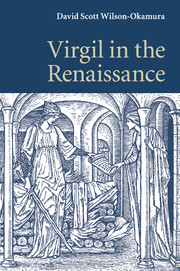Book contents
- Frontmatter
- Dedication
- Contents
- Illustrations
- Acknowledgements
- Texts and abbreviations
- Introduction
- Part I Publication
- Part II Reputation
- Chapter 2 Patronage and the Eclogues
- Chapter 3 Variety and the Georgics
- Chapter 4 Morals and minimalism
- Part III Interpretation
- Appendix A Virgil commentaries in Latin editions, 1469–1599
- Appendix B Virgil commentaries ranked by number of printings
- Index
- References
Chapter 2 - Patronage and the Eclogues
from Part II - Reputation
Published online by Cambridge University Press: 05 March 2014
- Frontmatter
- Dedication
- Contents
- Illustrations
- Acknowledgements
- Texts and abbreviations
- Introduction
- Part I Publication
- Part II Reputation
- Chapter 2 Patronage and the Eclogues
- Chapter 3 Variety and the Georgics
- Chapter 4 Morals and minimalism
- Part III Interpretation
- Appendix A Virgil commentaries in Latin editions, 1469–1599
- Appendix B Virgil commentaries ranked by number of printings
- Index
- References
Summary
Once out of nature I shall never take
My bodily form from any natural thing,
But such a form as Grecian goldsmiths make
Of hammered gold and gold enameling
To keep a drowsy Emperor awake.
W. B. Yeats, “Sailing to Byzantium”The idea of Virgil and its ancient sources
As we saw in the previous chapter, Virgil was printed first, even before Ovid, who was more popular. For St. Augustine, Virgil was “the greatest poet, and of all poets the most splendid and best.” For Lactantius, he was “the first of the Latin poets.” For Velleius Paterculus, “the prince of poets.” For Julius Caesar Scaliger, “the king of poets,” “the father of poesy,” even “the god of poets.” What was the basis for these broad claims? We know that most of the epics and pastorals written in the sixteenth century were modeled at least in part on Virgil’s Aeneid and Eclogues. But what made those poems worthy of imitation? And what was the idea of Virgil that poets carried in their heads, the image to which they aspired?
The history of classical scholarship has, as I said before, usually been told as a roll-call of great originals, of pioneers and pathfinders. Again, though, we need to distinguish between innovation and influence. To study influence, what we need to recover are the clichés: the chitchat about Virgil that could be exchanged over cocktails without fear of contradiction, because educated people had all learned more or less the same things in the course of their schooling, and could be expected to hold compatible views. These truisms, to give them no better name, are a better indication of what most readers – including most poets – knew or thought they knew about Virgil than the esoteric lucubrations of an Angelo Poliziano or a Joseph Scaliger.
- Type
- Chapter
- Information
- Virgil in the Renaissance , pp. 47 - 76Publisher: Cambridge University PressPrint publication year: 2010



